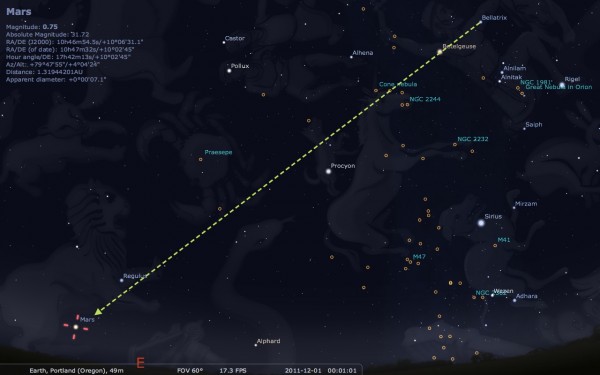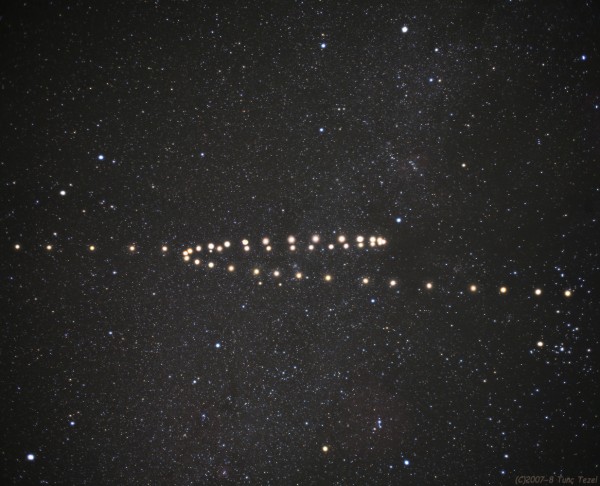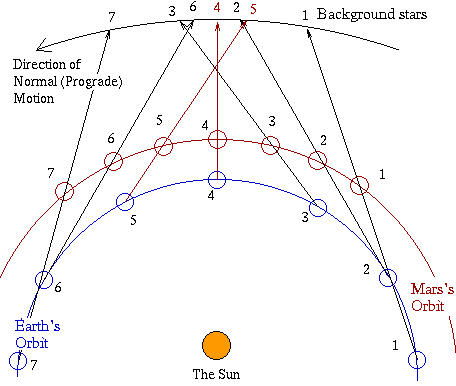"Years of science fiction have produced a mindset that it is human destiny to expand from Earth, to the Moon, to Mars, to the stars." -Barney Oliver
Just five days ago, the newest rover sent to Mars, Curiosity, was successfully launched aboard an Atlas V rocket.
But if you're anything like me, you can't just sit around and wait until its arrival in August of next year! After all my favorite rover is still rolling around on Mars after eight years, and has just uncovered something no other craft on Mars has seen before.
Say hello to Martian bedrock, with the mineral vein known as "Homestake" running through it. Just what is this vein running through the bedrock? Does the yellowish color indicate the presence of sulphur?
They know, but they won't tell me until they release their results at the upcoming American Geophysical Union's fall meeting.
What's an astrophysicist to do until then? Well, you can always simply enjoy Mars, but doing so now can be especially rewarding. First off, let's show you how to find and recognize it.
This is the famous winter constellation Orion, visible (at my latitude of 45° North) from the early evening (around 10 PM now) throughout the entire night.
But if you want to see Mars, it isn't rising until right around midnight. The good news is, if you can find Orion, you'll be able to find Mars easily, even in heavily light-polluted cities. Here's how.
If you can find Orion, look at the two stars highest above the horizon in the sky: they're named Bellatrix (the dimmer, bluer one) and (the yellower, brighter) Betelgeuse. Draw an imaginary line from Bellatrix to Betelgeuse that stretches far across the sky: maybe a third of the way across the entire horizon.
Just below the imaginary line drawn above, you'll pass Procyon, the seventh brightest star in the night sky, just a little less than halfway to where you want to wind up. About the same distance from Orion to Procyon will take you to Regulus, the brightest star in the constellation Leo (and 21st brightest overall in the night sky). Just a little further than Regulus will take you on to Mars, the red planet, which is noticeably brighter than all the stars in Leo at this time.
Winter is approaching on Mars, and we are approaching opposition, or the point in our orbit when Mars is closest to us. For those of you with telescopes and clear skies, although they're shrinking, the coming months will be a great time to look for Mars' polar ice caps.
But even those of you without telescopes will be in for a special treat.
If you went outside late at night/early in the morning for the next seven months or so, and just took a picture of the same part of the sky -- where Mars is -- every 10th day, what would you see?
Unlike most times of the year, where the planet Mars simply moves in the same direction across the sky, relative to the background of stars, Mars will enter retrograde in about two months. What does that mean?
It means that, during December and January, Mars will continue to move farther away from Regulus, but that motion will slow down and eventually stop. By time February comes around, Mars will begin appearing to move in the opposite direction, where it will speed up into March, slow down again, and once more come to a stop sometime in mid-April. And finally, it will move forward (away from Regulus) in its original direction, speeding along once more by time May ends and June comes along.
If you are savvy enough to take a large number of photos of the same region of the sky during this time, you too can obtain your own time-lapse image of retrograde motion!
If you don't catch it this time, you've got quite a wait on your hands: Mars goes into retrograde the least frequently of all the planets; the next time won't happen until mid-2014!
But why does Mars do this? If you had asked me a thousand years ago, I likely would have told you about Mars' epicycles.
We know that this old, Ptolemaic picture can accurately predict the apparent positions of the planets, but it is easy to show that this is not what's happening.
How so?
It fails when it tries to predict the distance to the planets: if the Ptolemaic picture of epicycles were correct, Mars would have to be closer to Earth during retrograde motion than it is during prograde motion, as you can clearly see above. But it also means that, if it's only slightly closer during retrograde, that means the epicycle has to be small, and even at its farthest point, Mars will never be all that much farther from Earth.
Ptolemy didn't have a telescope, of course, but if he did, here's what he would have noticed.
There are huge differences in the distance of Earth and Mars at different times of the year! If we prefer, we can measure the distance directly by, among other means, the time it takes to send-and-receive a light signal to my buddy on Mars!
So how do we explain both this prograde-stop-retrograde-stop-prograde motion and the distance to Mars at different times correctly?
Have the planets move in orbits around the Sun! Because the Earth sees Mars moving backwards not because Mars actually changes the direction of its orbit, but because Earth, being a faster-moving inner planet, passes by Mars with respect to the Sun!
The result, as seen from Earth, is this retrograde motion!
What about the distance to Mars? That gets taken care of -- for free -- too!
You can see the retrograde motion (and the entire loop) for yourself over the coming months; what a treat! But if you want to explain the entire orbit of Mars correctly, you need to get the distances right, too, which means no geocentric, epicycle-filled Solar System for you.
So when you enjoy this beautiful sight, just remember why Mars is moving this way: because the Earth overtakes Mars in its orbit! This is why we launched Curiosity when we did, so while it's on its way, why not go out and enjoy our closest approach to Mars and all the sights it gives us!
Update: for those of you who want to discover the latest Mars news as it comes in, give this a try!













Ethan, off-topic: Just wanted to say thanks for your blog. You have a real talent for communication. Keep up the awesome work! And let us know when you're ready to show the site you're now editing for!
Ben,
You're very welcome! And if you want to play detective, you're welcome to follow the link after the update above...
Ethan,
The Yellow could be from sulphur, but most likely it is the Iron Oxide mineral "limonite." :-) I can't wait to hear for sure myself. dp
My guess is that it is ankerite, CaFe(CO3)2
http://www.galleries.com/Ankerite
"This is why we launched Curiosity when we did..."
That was almost a throw-away comment, but not until I read it did it occur to me that the timing of the launch of Curiosity and the occurance of Mars' apparent retrograde motion were connected. What better time to launch a mission to Mars then as Earth steams right past the red planet?
Nice use of Stellarium. I'm a big fan of Celestia as well.
You really put a lot of effort into your visual aids.
It's unfortunate we have to destroy our own planet to observe others. Look at the pollution coming out of that rocket!